Tips To Be Able To See Northern Lights Tonight
The National Oceanic and Atmospheric Administration (NOAA) Space Weather Prediction Center (SWPC) OVATION Aurora Forecast Model is updated every 30 minutes. The animation shows auroral activity that occurred over the Northern Hemisphere in the last 24 hours. Fast forward to the last few seconds of the animation to see what is predicted for the next 30 minutes.
Tips to be able to see northern lights in Georgia tonight
May 12, 2024
Universal Time
HIGH(+) ACTIVITY
KP INDEX: 0 1 2 3 4 5 6 7 8 9
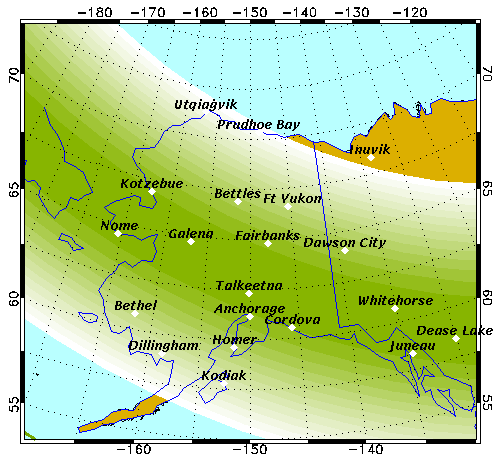
The aurora forecast is updated daily at midnight UTC.
![]()
N. America
![]()
Europe
![]()
N. Pole
![]()
S. Pole
![]()
Alaska
Forecast: Auroral activity will be high(+). Weather permitting, highly active auroral displays will be visible overhead from Utqiaġvik to as far south as Kodiak and King Salmon.
Moon phase: Waxing Crescent
27 Day Forecast
Kp < 4
Kp = 4
Kp > 4
Note: Predicted Kp values update every Monday at noon UTC.
FREQUENTLY ASKED QUESTIONS
FORECASTING THE AURORA
What’s happening now?
Magnetometers provide an alternative view of the level of geomagnetic disturbance occurring. A sudden steep change in the magnetometer is usually an indicator that an extended period (0.5 hours or more) of active aurora is beginning. This is especially true before 2 or 3 a.m. Scientists also find it helpful to see the time history of the magnetometer trace, since other indicators, like the all-sky camera, only show current conditions.
Visit the magnetometer monitor for a chart of the current conditions.
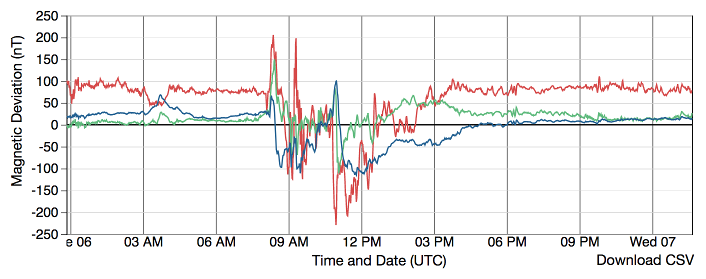
1-hour Forecast
The National Oceanic and Atmospheric Administration (NOAA) Space Weather Prediction Center (SWPC) OVATION Aurora Forecast Model is updated every 30 minutes. The animation shows auroral activity that occurred over the Northern Hemisphere in the last 24 hours. Fast forward to the last few seconds of the animation to see what is predicted for the next 30 minutes.
The aurora is not visible during daylight hours. Therefore, the model indicates the sunlit side of Earth in blue and the nightside hours in grayscale.
3-day Forecast
Remote sensing spacecraft also monitor the sun for indications of impulsive eruptions that eject material toward Earth, or regions where continuous high-speed streams of material are escaping and heading Earthward. In either case, the travel time to Earth for such material leaving the sun is 1 to 3 days. This allows good forecasts to be made on these look-ahead time scales, based on events and conditions observed on the sun.
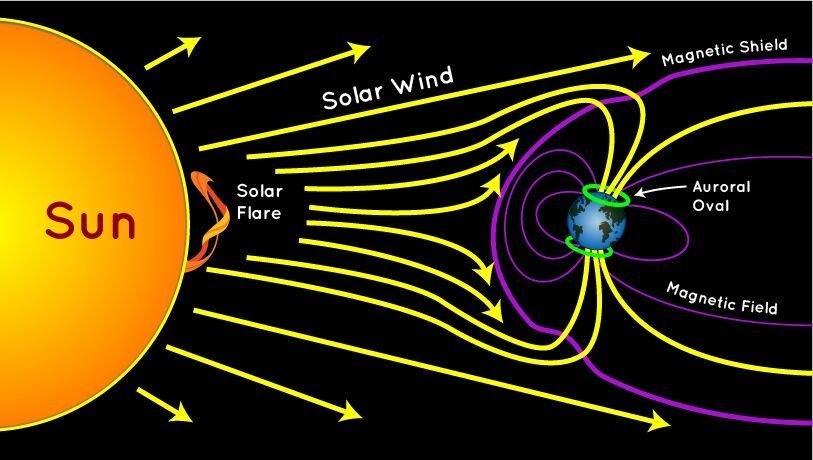
27-day Forecast
Just as Earth rotates on its axis making a complete rotation every 24 hours, the sun spins on an axis making a complete rotation in 27 days. Solar phenomena on the surface of the sun distribute high speed plasmas that often result in increased auroral activity on earth. These phenomena may be sunspots, coronal mass ejection, filaments, or a prominence. As the sun rotates, the solar phenomena and resulting areas of high-speed plasma are likely to reoccur every 27 days until the phenomena dissipate. Therefore, if there is high auroral activity today it’s possible that there will be high auroral activity again in 27 days. This 27 day rotation is called a Carrington Rotation.
VIEWING THE AURORA
How often can I see aurora?
There is always some aurora at some place on earth. When the solar wind is calm, the aurora might only be occurring at very high latitudes and might be faint, but there is still aurora. In order for us to see the aurora, however, the sky must be dark and clear. Sunlight and clouds are the biggest obstacles to auroral observations.
Where is the best place to see aurora?
The best places to view aurora are high northern latitudes during the winter in Alaska, Canada, and Scandinavia. Furthermore, there is quite strong (but poorly understood) tendency for auroral activity to be stronger at equinox than it is at solstice. This so-called “Russell-McPherron effect” means that the statistical likelihood of seeing aurora over interior Alaska is roughly twice as high at equinox as it is at solstice. Combined with a slight preference for better weather in spring than in fall, this means that late February to early April are usually considered the best aurora viewing months in Alaska.
To see aurora you need clear and dark sky. During very large auroral events, the aurora may be seen throughout the U.S. and Europe, but these events are rare. During an extreme event in 1958, the aurora was visible from Mexico City.
During average activity levels, auroral displays will be overhead at high northern or southern latitudes. Places like Fairbanks, Alaska; Dawson City, Yukon; Yellowknife, NWT; Gillam, Manitoba; the southern tip of Greenland; Reykjavik, Iceland; Tromsø, Norway; and the northern coast of Siberia all offer a good chance to view the aurora overhead.
In North Dakota, Michigan, Quebec, and central Scandinavia, you might be able to see aurora on the northern horizon when activity picks up a little. In the southern hemisphere the aurora has to be fairly active before it can be seen from places other than Antarctica. Hobart, Tasmania, and the southern tip of New Zealand have about the same chance of seeing aurora as Vancouver, BC, South Dakota, Michigan, Scotland, or St. Petersburg, Russia. Fairly strong auroral activity is required for aurora viewing in those locations.
What is the best time of day to see aurora?
The best time to watch for aurora is the three or four hours around midnight, but aurora occurs throughout the night. Active auroral displays tend to be more diffuse and fragmented later in the night, which means that 9 p.m. to 3 a.m. is typically the time period with the highest probability of seeing spectacular auroral displays over interior Alaska in winter. Since clear sky and darkness are both essential to see aurora, the best time is dictated by the weather and by the sunrise and sunset times. The moon is also very bright and can make it more difficult to view the aurora, so lunar cycles should be taken into account.
What period of night does the date on the aurora forecast refer to?
The Aurora forecast is in Universal Time (UTC), which is eight hours ahead of Alaska time. This means midnight universal time is 4 p.m. Alaska time. If you want to know Alaska’s night forecast from midnight to sunrise, when the aurora is often more active, you should look at the next day’s forecast. For example, if you want to know the forecast for auroral activity in Alaska for the night of March 1 and early morning of March 2, look at the forecast for March 2, UTC.
What is the best time of year to see aurora?
Clear skies are a requirement, so you should try to choose a location and a season that is blessed with the clearest skies. The continental locations in Russia, Alaska and western Canada under the auroral zone statistically have the clearest skies. Note that during the spring, the skies of Iceland and Scandinavia are usually clear. So the dark of the moon in March is the best time of year to travel to the auroral zone since the yearly cycle of auroral activity also peaks around the equinox.
Sunlight prevents viewing the aurora during the summer at high latitudes. The skies at night are simply too bright as the sun climbs in the sky until the June 21 solstice and then descends. Here in Fairbanks, at about latitude 64.8, our aurora viewing “season” is August 21 to April 21. The odds are in your favor between those dates: if the weather is clear and you stay for at least three nights, it’s highly likely (though never certain!) that you will see the aurora. From April 22 to August 20 although the sun does set the sky never gets dark enough in Fairbanks to see the aurora even if it was a spectacular display.
Why are some years better than others to view the aurora?
The number of sunspots on the Sun’s surface changes on a fairly regular cycle, which scientists refer to as the sun’s 11-year cycle variation. Sunspot activity, and hence auroral activity, tends to peak every 11 years. This peak is called the solar maximum. The last solar maximum was in 2014; the next is expected around 2025. The chances of seeing the aurora at lower latitudes increase when the sunspot cycle is at a maximum, but chances at higher latitudes are not as dependent on the solar maximum because the auroral oval is normally present.
Where should I view the aurora when I’m in Fairbanks, Alaska?
For specific information on accommodations, tour companies, etc., we suggest www.explorefairbanks.com.
People who live in Fairbanks, Alaska, are accustomed to spectacular views of the aurora borealis. Many residents routinely stay up late to photograph this phenomenon or just to experience the widely different forms it takes with each new display. Some people view the aurora from their homes, but many travel away from the city lights for the most spectacular views.
The best time of year for aurora viewing is in the spring when the probability for clear skies is twice as likely as in the fall. The two weeks around the new moon in March is best; viewing can be good from early January to late April, however.
If you come in the fall, the last two weeks of August and the first three weeks of September are best for weather, but the aurora is there behind the clouds (60 percent probability) during the entire winter.
The time for viewing is between evening and morning civil twilight (when the sun is 6 degrees below the horizon) on clear or even partly cloudy nights. Major solar storms can occur any time; the aurora is usually most intense between 10 p.m. and 2 a.m. Viewing is best with little or no moonlight so if you can, avoid the weeks around a full moon.
Visitors to Fairbanks should plan to watch from a hill away from city lights with a clear view of the horizon, since the aurora can occur in any part of the sky. During solar activity maximum years, most auroral storms start south of Fairbanks. During years of minimum solar activity, auroral storms start north of Fairbanks and occur in the midnight hours.
Although trees make good foreground in auroral photographs, too many of them can limit the full experience of the aurora. Another concern for visitors is extremely cold winter weather. In those conditions small problems may be magnified into disaster at a site that is too remote.
At some Fairbanks hotels you may be able to arrange for a wake-up call if the aurora is out.
Recommended aurora viewing sites around Fairbanks include:
- Chena Lakes Recreation Area
- Tanana Lakes Recreation Area, just south of Fairbanks
- Ester, Wickersham and Murphy Domes
- Haystack Mountain on the Elliot Highway
- Some turnouts along the Elliot, Steese and Parks Highways
- Chena Hot Springs Resort on Chena Hot Springs Road
See the Explore Fairbanks Winter Guide https://www.explorefairbanks.com/explore-the-area/travel-tips/visitor-and-winter-guides/
We should mention also that there might be some people who are hoping to hear the aurora. This is a once-in-a-lifetime experience for the aurora watcher. It may only be accomplished successfully during the most active overhead displays, on windless nights and away from any other noise sources such as barking dogs or traffic noise.
SCIENCE OF THE AURORA
What is the aurora?
The aurora is a luminous glow seen around the magnetic poles of the northern and southern hemispheres. The light is caused by collisions between electrically charged particles streaming out from the sun in the solar wind that enter Earth’s atmosphere and collide with molecules and atoms of gas, primarily oxygen and nitrogen.
When the electrons and protons from the sun collide with oxygen and nitrogen in the Earth’s atmosphere, they gain energy. To get back to their normal state, they release that energy in the form of light. The principle is similar to what happens in a neon light. Electricity runs through the light fixture to excite the neon gas inside, and when the neon is excited, it gives off a brilliant light.
The dancing lights of the aurora are seen around the magnetic poles of the northern and southern hemispheres because the electrons from the sun travel along magnetic field lines in the Earth’s magnetosphere. The magnetosphere is a vast, comet-shaped bubble around our planet. As the electrons from the solar wind penetrate into the upper atmosphere, the chance of colliding with an atom or molecule increases the deeper into the atmosphere they go.
What is the auroral oval?
The two figures below show the locations with the most frequent occurrences of aurora borealis (left) and aurora australis (right) during the period of best viewing around the middle of the night.
This level of auroral activity, index Kp=2, will occur often enough that you will probably see the aurora if you travel to these regions when the nights are dark and stay for three days to a week, assuming that the skies are clear. If the auroral activity level is higher than 2, you will still observe the stronger motions and color changes, etc., that are seen farther equatorward.
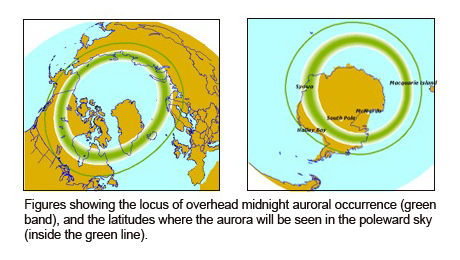
What makes the colors of the aurora?
The composition and density of the atmosphere and the altitude of the collisions determine the colors. The aurora is most often seen as a striking green, but it also occasionally shows off other colors, ranging from red to pink or blue to purple. Oxygen at about 60 miles up gives off the familiar green-yellow color, oxygen at higher altitudes (about 200 miles above Earth’s surface) gives all-red auroras. Nitrogen in different forms produces the blue and red-purple light.
Cameras have different sensitivities to colors than the human eye, therefore there is often more red aurora in photos than you can see with the unaided eye. Just like sunlight, which appears to be white, is a blend of the colors of the rainbow, the aurora is also a mixture of colors. The overall impression is a greenish-whitish glow. Since there is more oxygen at high altitudes, the red aurora tends to be on top of the regular green aurora. Very intense aurora often has a purple rim at the bottom. The purple results from a mixture of blue and red emissions from nitrogen molecules.
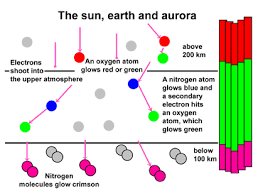
Anyone can join.
Anyone can contribute.
Anyone can become informed about their world.
"United We Stand" Click Here To Create Your Personal Citizen Journalist Account Today, Be Sure To Invite Your Friends.
Please Help Support BeforeitsNews by trying our Natural Health Products below!
Order by Phone at 888-809-8385 or online at https://mitocopper.com M - F 9am to 5pm EST
Order by Phone at 866-388-7003 or online at https://www.herbanomic.com M - F 9am to 5pm EST
Order by Phone at 866-388-7003 or online at https://www.herbanomics.com M - F 9am to 5pm EST
Humic & Fulvic Trace Minerals Complex - Nature's most important supplement! Vivid Dreams again!
HNEX HydroNano EXtracellular Water - Improve immune system health and reduce inflammation.
Ultimate Clinical Potency Curcumin - Natural pain relief, reduce inflammation and so much more.
MitoCopper - Bioavailable Copper destroys pathogens and gives you more energy. (See Blood Video)
Oxy Powder - Natural Colon Cleanser! Cleans out toxic buildup with oxygen!
Nascent Iodine - Promotes detoxification, mental focus and thyroid health.
Smart Meter Cover - Reduces Smart Meter radiation by 96%! (See Video).





